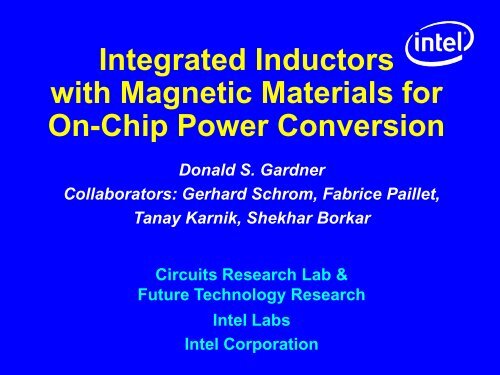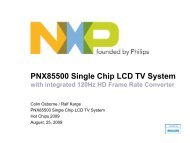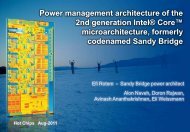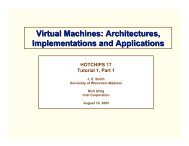Integrated Inductors with Magnetic Materials for On-Chip ... - Hot Chips
Integrated Inductors with Magnetic Materials for On-Chip ... - Hot Chips
Integrated Inductors with Magnetic Materials for On-Chip ... - Hot Chips
Create successful ePaper yourself
Turn your PDF publications into a flip-book with our unique Google optimized e-Paper software.
<strong>Integrated</strong> <strong>Inductors</strong><br />
<strong>with</strong> <strong>Magnetic</strong> <strong>Materials</strong> <strong>for</strong><br />
<strong>On</strong>-<strong>Chip</strong> Power Conversion<br />
Donald S. Gardner<br />
Collaborators: Gerhard Schrom, Fabrice Paillet,<br />
Tanay Karnik, Shekhar Borkar<br />
Circuits Research Lab &<br />
Future Technology Research<br />
Intel Labs<br />
Intel Corporation
Outline<br />
• DC Voltage Converters<br />
– Comparison of buck converters<br />
– Comparison of inductors <strong>with</strong> magnetic films<br />
• <strong>Magnetic</strong> material properties<br />
– <strong>Magnetic</strong> hysteresis loops<br />
– Complex permeability spectra<br />
• <strong>Inductors</strong><br />
– Structure cross sections<br />
– Inductance measurements<br />
– Eddy current and skin effect<br />
– Sheet and shunt inductance
Multi-Core Power Management<br />
Voltage Regulator<br />
Voltage Regulator<br />
Voltage Regulator<br />
Voltage Regulator<br />
Voltage Regulator<br />
• Today - Coarse Grain Power Management<br />
– same voltage to all the cores, variable voltage<br />
• Future – Fine Grain Power Management<br />
– each core or cluster of cores operates at the<br />
optimum voltage
tm<br />
tc<br />
Two-Phase Buck Converter<br />
wc insulator<br />
<strong>with</strong> Coupled <strong>Inductors</strong><br />
magnetic material (CZT=CoZrTa)<br />
Al or Cu wires<br />
Inductor Power Losses<br />
DC loss component<br />
AC loss component<br />
2<br />
2 ∆I<br />
p−<br />
p<br />
P LOSS = RDC<br />
× I Lavg + RAC<br />
× +<br />
Load dependent<br />
∆I<br />
D<br />
f<br />
s<br />
p _ p<br />
=<br />
=<br />
=<br />
( 1<br />
dutycycle<br />
− D)<br />
V<br />
f L<br />
s<br />
frequency<br />
Fundamentals of Power Electronics by Robert W. Erickson<br />
eff<br />
12<br />
P<br />
Frequency dependent<br />
out<br />
hys
100~480 MHz Switching Regulator<br />
Discrete<br />
<strong>Inductors</strong><br />
V VIN IN =1.2V, V OUT =0.9V, L=6.8nH, F=233MHz<br />
Φ 0<br />
Φ 1<br />
Φ 2<br />
Φ 3<br />
4.3ns<br />
• High frequency<br />
• Hysteretic multi-phase topology 1ns response<br />
• 88% efficiency<br />
Schrom, Gardner, et.al., IEEE PESC 2004 and IEEE VLSI Symp. 2004.
Comparison of DC Converters<br />
[3] [4] [5] [6] [7] Pavo-1<br />
Year 1996 1999 2000 2002 2002 2004<br />
Tech [µm] n/a 0.25 n/a 0.25 n/a 0.09<br />
# phases 1 1 1 1 1 4<br />
V IN [V] 4 3 4 2.5 3.6 1.2<br />
V OUT [V] 3.3 2 3 1.4 2.7 0.9<br />
f [MHz] 1.6 0.5 3 0.75 1.8 233<br />
Eff. [%] 85 94 83.3 95 80 83.2<br />
L TOT [µH] 3 10 1 15.2 1 0.0017<br />
C [µF] n/a 47 1 21.6 n/a 0.0025<br />
I MAX [A] 0.3 0.25 0.33 0.25 0.3 0.3<br />
Area [mm 2 ] n/a 0.46 20 0.35 n/a 0.14<br />
100x<br />
higher f<br />
1000x<br />
Smaller<br />
L and C
Package-<strong>Integrated</strong> VR <strong>with</strong><br />
Intel ® Core 2 Duo Processor<br />
• Vin = 3V, Vout = 0~1.6V<br />
• f = 10~100 MHz<br />
• Current = 50 Amps / 75 Amps peak<br />
• Size = 37.6 mm 2 , 130 nm CMOS
Efficiency Measurements<br />
• Package embedded air core inductors: 84.9%<br />
• Discrete powdered Fe core inductors:87.9%<br />
• Load adaptive bridge activation improved by >10%<br />
G. Schrom et. al., APEC, Paper #SP1.4.2, p. 75, 2010
RF CMOS <strong>Integrated</strong> Circuit<br />
<strong>Inductors</strong> make up 24% of this chip<br />
Inductance density of spirals is small (
Inductance Densities vs. Q-Factor<br />
from the Literature<br />
Gardner, Jamieson, et.al. IEEE Trans. <strong>Magnetic</strong>s, 45, pp. 4760, 2009.
<strong>Magnetic</strong> Hystersis Loops<br />
<strong>for</strong> CoZrTa & NiFe<br />
Slope µ = 1050<br />
Slope µ = 3000
Permeability vs. Applied <strong>Magnetic</strong> Field<br />
<strong>Magnetic</strong> anisotropy H k has two components:<br />
The intrinsic induced anisotropy from the deposition<br />
The demagnetizing energy caused by the sample shape
Complex Permeability Model<br />
δ =<br />
2ρ<br />
ωµ iµ o<br />
δ = skin depth<br />
ρ = resistivity of magnetic film<br />
ω = frequency<br />
µ i = relative dc permeability<br />
d = film thickness<br />
µ =<br />
µ<br />
i<br />
( 1<br />
2δ ( 1+<br />
j)<br />
d<br />
tanh<br />
+ j)<br />
d 2δ<br />
High resistivity materials<br />
are needed to reduce<br />
the eddy currents and<br />
increase the skin depth.<br />
CoZrTa ρ = 100 µΩ-cm
Permeability Spectra of CoZrTa<br />
Real Component Imaginary Component
Permeability Spectra of CoZrTa<br />
Real Component Imaginary Component
Inductance Modeling of Wire<br />
<strong>with</strong> <strong>Magnetic</strong> Material<br />
<strong>Magnetic</strong> Material<br />
Wire<br />
<strong>Magnetic</strong> Material<br />
Maximum Increase in Inductance<br />
1 layer magnetic film ≤ 2 ×<br />
2 layers magnetic film ≤ µ r ×
Hard<br />
Spiral and Transmission Line <strong>Inductors</strong><br />
Easy<br />
Structures take advantage of the<br />
uniaxial magnetic anisotropy.
Hard<br />
Axis<br />
Cross-Sectional Image of Inductor<br />
in 130 nm 6-level Metal CMOS Process<br />
CoZrTa<br />
Inductor Metal<br />
CoZrTa<br />
Cu (M6)<br />
Cu (M5)<br />
Cu (M4)<br />
Cu (M3)<br />
Cu (M2)<br />
Cu (M1)<br />
<strong>Magnetic</strong><br />
Via
Spiral <strong>Inductors</strong> <strong>with</strong> Single <strong>Magnetic</strong> Layer<br />
Increase in inductance is small (10~30% at up to 9.8 GHz)
Spiral <strong>Inductors</strong> <strong>with</strong> Two <strong>Magnetic</strong> Layers<br />
Inductance increases by 9 ×
<strong>Magnetic</strong> Flux Density At 1GHz<br />
Unlaminated<br />
Cobalt alloy<br />
Laminated<br />
Cobalt alloy<br />
Skin-depth effect limits penetration of B-field.<br />
Larger skin depth results in lower losses.<br />
B-field (T)<br />
4.0<br />
3.6<br />
3.2<br />
2.8<br />
2.4<br />
2.0<br />
1.6<br />
1.2<br />
0.8<br />
0.4<br />
0.0
Inductance vs. Frequency of Spirals<br />
Inductance density is 1,700 nH/mm 2<br />
Roll off is from resonance (1/√LC) of inductor.
Hard<br />
Easy<br />
Spiral and Stripe <strong>Inductors</strong><br />
Using 5um thick Copper<br />
Structures take advantage of the<br />
uniaxial magnetic anisotropy.
<strong>Magnetic</strong><br />
Via<br />
Cross-Sectional Image of Inductor<br />
in 90 nm CMOS Process<br />
90 nm 7-level Metal CMOS Process<br />
<strong>Magnetic</strong><br />
Via
Hard<br />
Axis<br />
Cross-Sectional Image of Inductor
Stripe <strong>Inductors</strong><br />
With Thick Copper<br />
Inductance increases by up to over 30×
Inductance Modeling of Rectangular Line<br />
L<br />
1/L<br />
≈<br />
1/L shunt<br />
t<br />
µ m<br />
0µ r<br />
2<br />
W tot<br />
⎛<br />
⎜<br />
⎝<br />
l<br />
w<br />
⎞<br />
⎟<br />
⎠<br />
1/l·L sheet<br />
l = line length<br />
w = line width<br />
t m = magnetic film thickness<br />
µ r = relative dc permeability<br />
Eqn. from V. Korenivski and R. B. van Dover, JAP, v. 82 (10), 1997<br />
w
<strong>Magnetic</strong> Via Widths<br />
Inductance increases <strong>with</strong> via width,<br />
but the change becomes diminishingly small.
Sheet and Shunt Inductances<br />
Sheet inductance is independent of the magnetic via width.<br />
Shunt inductance increases <strong>with</strong> increasing via width.
Unlaminated<br />
Cobalt alloy<br />
Laminated<br />
Cobalt alloy<br />
Current Density At 100 MHz<br />
Eddy currents are reduced by laminations.<br />
J(A/m 2 )<br />
1E+9<br />
9E+8<br />
8E+8<br />
7E+9<br />
6E+8<br />
5E+8<br />
4E+9<br />
3E+8<br />
2E+8<br />
1E+8<br />
0E+0
Analytical Modeling of Q-Factor<br />
Thinner films give higher Q-factors, but lower inductance.
Analytical Modeling of Q-Factor<br />
Laminations increase the Q-factor.
Quality Factor of <strong>Inductors</strong><br />
With Laminated <strong>Magnetic</strong> Films<br />
Peak quality factor is increased,<br />
But quality factor at lower frequencies decreased.
Summary<br />
• DC Voltage Converters<br />
– High-frequency buck converters<br />
– High inductance density needed<br />
– Low DC resistance important<br />
• <strong>Magnetic</strong> materials<br />
– Complex permeability (real and imaginary)<br />
– Low hysteretic losses<br />
– CMOS compatibility (thermal, process compatibility)<br />
• <strong>Inductors</strong> <strong>with</strong> magnetic material<br />
– Single films increase inductance by ≤30% up to 9.8 GHz<br />
– <strong>Magnetic</strong> vias – Sheet inductance vs. shunt inductance<br />
– 2 magnetic films increase inductance<br />
• Over 30× compared to air-core<br />
• 200 nH inductors possible (1,700 nH/mm 2 )
For More In<strong>for</strong>mation<br />
• IEEE Trans. <strong>Magnetic</strong>s, 45, pp. 4760, 2009.<br />
• Journal of Applied Physics, 103, pp. 07E927, Apr. 1,<br />
2008.<br />
• IEEE Trans. <strong>Magnetic</strong>s, 43, pp. 2615, 2007.<br />
• IEEE PESC 2004 and IEEE VLSI Symp. 2004.<br />
• APEC, Paper #SP1.4.2, p. 75, 2010.<br />
• Intl. Electron Devices Meeting (IEDM), pp. 221-224,<br />
2006.<br />
• IEEE Intl. Interconnect Technology Conference,<br />
pp.101–103, 2001.








